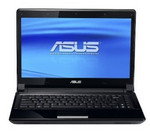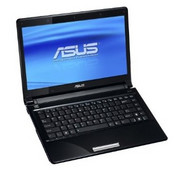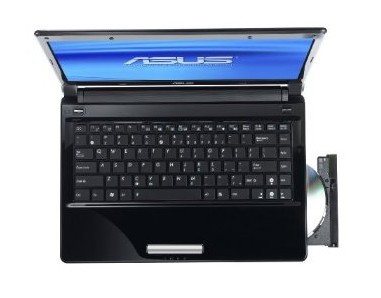Asus UL80Vt
Specifications

Price comparison
Average of 6 scores (from 7 reviews)
Reviews for the Asus UL80Vt
Source: AnandTech
 Archive.org version
Archive.org versionWe've already discussed our thoughts on the UL80Vt and G51J - you can read the details on pages two and three. Both are great laptops, and while we didn't give either the coveted Gold award they are closer than we've come in quite some time. For those that are wondering, anything earning a Bronze Editors' Choice is (at least in my mind) a 90% score; Silver means 93%, and Gold means 95% or higher. Basically, Gold awards are reserved for unequivocal recommendations, and we do have a few minor complaints with both of these laptops, mostly oriented around the LCDs.
Single Review, online available, Long, Date: 12/15/2009
Rating: Total score: 94%
Source: Good Gear Guide
 Archive.org version
Archive.org versionASUS' UL80Vt is a 14in notebook that's built for people who want plenty of features and good speed, yet want a laptop that's reasonably light and capable of lasting a long time away from a power outlet. If a reasonably thin and light notebook with excellent battery life sounds like your cup of tea, then the ASUS UL80Vt is for you. At 14in it's easy to use, yet not a burden to carry around. It's well built, looks good and performs well, but it does lack some connectivity options such as eSATA.
Single Review, online available, Medium, Date: 12/14/2009
Rating: Total score: 80%
Source: Hot Hardware
 Archive.org version
Archive.org versionThe UL80Vt isn't perfect though. While the keyboard was stellar and the multi-touch aspect of the trackpad were a plus, we still aren't into the dimpled pad and the glossy LCD. For those working outdoors, this screen could potentially be a major nuisance. Also, the relatively low 1366x768 resolution is nothing to write home about, and the slower 5400rpm (320GB) hard drive isn't all that quick when it comes time to boot or load applications for the first time. Still, we think the positives far outweigh the negatives when all things are considered. For just over $800, this is a really well-rounded machine.
Single Review, online available, Very Long, Date: 11/25/2009
Rating: price: 90% performance: 80% display: 40% mobility: 80% emissions: 90%
Source: Computer Shopper
 Archive.org version
Archive.org versionIf you need an everyday laptop that offers portability and a full list of features at a reasonable price, look no further than the Asus UL80Vt. It’s the best 14-inch thin-and-light available for the price ($849 list, or around $825 on the street), delivering no-excuses performance—including surprising 3D-gaming chops—plus battery life when you need it, all in a sleek, slim design. Long battery life and good performance help make the feature-packed UL80Vt today's best under-$1,000 thin-and-light.
Single Review, online available, Long, Date: 11/01/2009
Rating: Total score: 87%
Foreign Reviews
Source: Magnus.de
 DE→EN Archive.org version
DE→EN Archive.org versionSingle Review, online available, Medium, Date: 03/08/2010
Rating: Total score: 100%
Source: Notebookjournal
 DE→EN Archive.org version
DE→EN Archive.org versionSingle Review, online available, Very Short, Date: 12/03/2009
Rating: Total score: 90% price: 80% performance: 70% features: 30% display: 30% mobility: 70% workmanship: 70% ergonomy: 70%
Source: Retera
 RU→EN Archive.org version
RU→EN Archive.org versionSingle Review, online available, Long, Date: 03/10/2010
Rating: Total score: 71% performance: 44% display: 58% mobility: 72% emissions: 44%
Comment
NVIDIA GeForce G210M: The GeForce G210M is the successor of the G110M and also possesses 16 shader cores. Because of the 40nm process, the chip is clocked much higher but is still staying in the same power envelope.
Only some 3D games with very low demands are playable with these cards.
» Further information can be found in our Comparison of Mobile Graphics Cards and the corresponding Benchmark List.
Intel Core 2 Duo: This is the Core Duo and Core Solo successor with a longer pipeline and 5-20% more speed without more power consumption. As an addition to the Core Duo design there exists a fourth decoder, an amplified SSE-unit and an additional arithmetical logical unit (ALU).
The Core 2 Duo for laptops is identical to the desktop Core 2 Duo processors but the notebook-processors work with lower voltages (0.95 to 1188 Volt) and a lower Frontside bus clock (1066 vs 667 MHz). The performance of equally clocked notebooks is 20-25% lower than Desktop PCs because of the lower Frontside bus clock and the slower hard disks.
SU7300: Slow clocked dual core processor with a low TDP of 10 Watt.» Further information can be found in our Comparison of Mobile Processsors.















